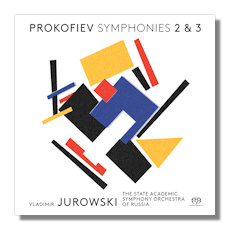
The Internet's Premier Classical Music Source
Related Links
- Prokofieff Reviews
- Latest Reviews
- More Reviews
-
By Composer
-
Collections
DVD & Blu-ray
Books
Concert Reviews
Articles/Interviews
Software
Audio
Search Amazon
Recommended Links
Site News
 SACD Review
SACD Review
Serge Prokofieff

- Symphony #2 in D minor, Op. 40
- Symphony #3 in C minor, Op. 44
State Academic Orchestra of Russia/Vladimir Jurowski
Pentatone SACD PTC5186624 72:45 Hybrid Multichannel
This is the start of yet another Prokofiev symphony cycle, the seventh (or maybe even eighth) in less than a decade. Karabits (Onyx), Alsop (Naxos), Litton (BIS), Gergiev (Mariinsky), Ashkenazy (Exton), and Gaffigan (Challenge Classics) are the most recent entries, a few of which are still ongoing projects as I write this. I have covered these here, except for the Ashkenazy, and have found something to admire in all of them. The better ones of these include Alsop, Litton and Gergiev, who also has a completed cycle on Decca from 2006.
Young Vladimir Jurowski has already done the Fifth Symphony for Pentatone, but that effort dates back a decade now and will not be a part of this cycle, or so the statements by the conductor suggest in the album notes. Thus a new Fifth will also be forthcoming, which is good news because I found his older recording of the Fifth a bit dubious (Pentatone SACD PTC5186083).
To launch this new cycle Jurowski takes on perhaps the two toughest symphonies to bring off in Prokofiev's output. The Symphony #2 has always seemed to provoke sharp comments from musicologists and reviewers regarding how challenging or difficult it is for the listener to grasp. Well, it isn't a difficult work to understand, at least to the ear that has experienced a decent variety of classical orchestral works. If you find The Rite of Spring listenable, this work will present few problems, and its decibel level is far lower. Actually, I believe this is one of the stronger symphonies in Prokofiev's canon, and Jurowski clearly attempts to elucidate some of the dense scoring, especially in the first movement. He succeeds in his approach, allowing you to hear the many competing lines, the plentiful contrapuntal activity and the brass underpinnings, particularly from the tuba. Instruments that are often buried in other performances are thus often audible here.
But Jurowski isn't merely set on clarity: he presents the music in all its power and defiance, in all its colorful urgency and occasional lyrical beauty in a well-crafted interpretation whose tempos are nearly always right on target throughout the symphony. Everything works here: try the first movement development section where the buildup and climax emerge with crispness and power, not with the messy sonorities you sometimes hear in other performances. The sixth and final variation in the second movement comes across with as much tension and explosiveness in the buildup and climax as I've ever heard, and for once the music doesn't drag or sound bloated, as the final march-like outburst rings out with a stomping finality as if sweeping away all conflict to allow the return of the main theme to bring on a sense of peace and serenity.
The Third Symphony is a more Romantic, if still quite stormy work than the Second, though some listeners have found its ethereal and otherworldly character somewhat challenging. The symphony is based on Prokofiev's fantastic opera The Fiery Angel, which involves demonic possession and other horrors, a work not far in spirit from The Exorcist. Jurowski points up the richly beautiful but agitated character of the two main themes in the first movement and goes on to deliver one of the best accounts of the development section ever put on record. The march at the climax comes across with great power and, unlike so many other recordings, at a fairly moderate tempo, the only way to play this music effectively. So many Russian conductors rush this section, giving it a jazzy, almost lighthearted, sassy character that usually doesn't work.
The remaining movements are delivered with the same kind of intelligence and artistry. Like the Second, this account of the Third is one of the finest on record. The State Academic Orchestra of Russia plays brilliantly in both works, obviously showing a kinship and idiomatic grasp of the musical style of Prokofiev. Now there are many fine recordings of these two symphonies to choose from: Alsop, Karabits and Gergiev/Chandos (not part of either of his cycles) in the Second; Muti/Philips, Leinsdorf/Sony, and Kitayenko/Capriccio & Phoenix Editions in the Third, to name just a few of the better ones of each. In the end, I would have no problem selecting Jurowski as a top choice in these two symphonies. So far, his cycle of Prokofiev symphonies promises to be among the finest. Excellent sound reproduction by Pentatone rounds out this fine SACD. Highest recommendations!
Copyright © 2018, Robert Cummings


















